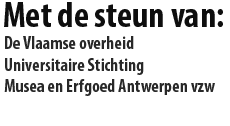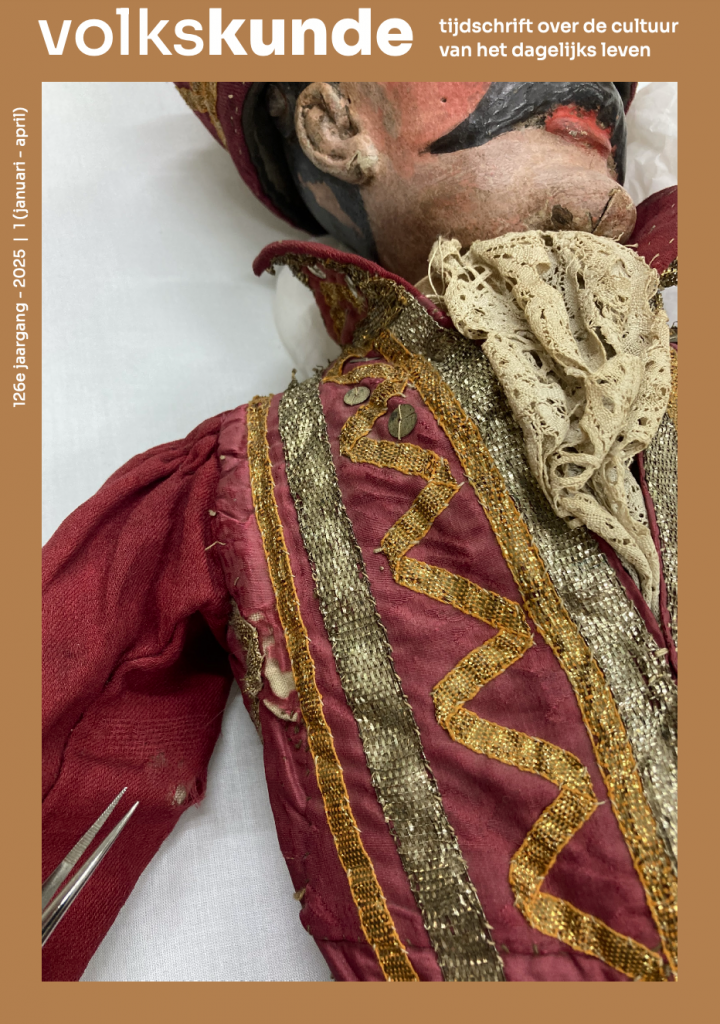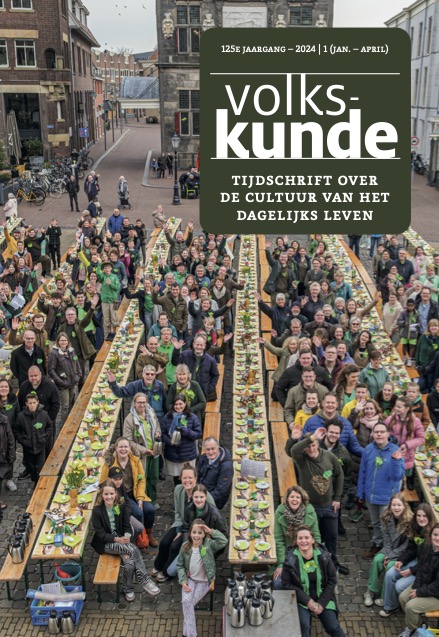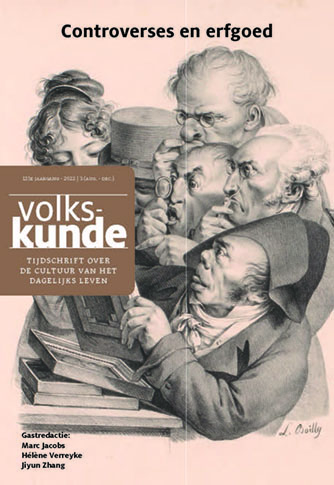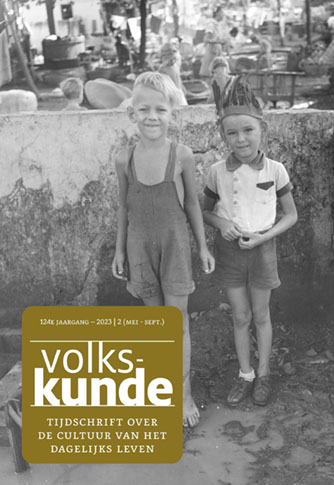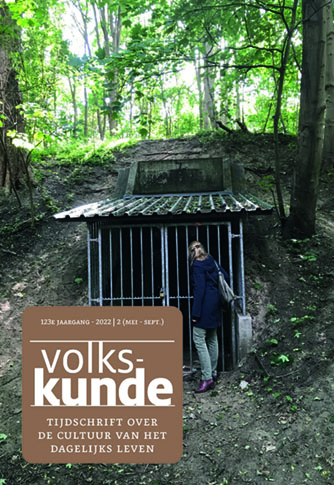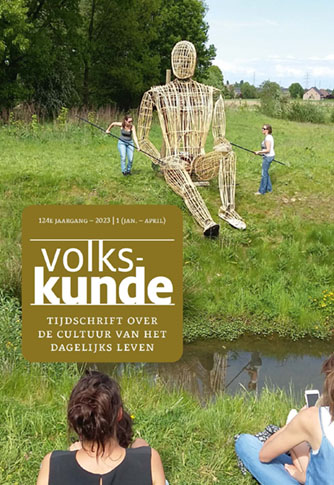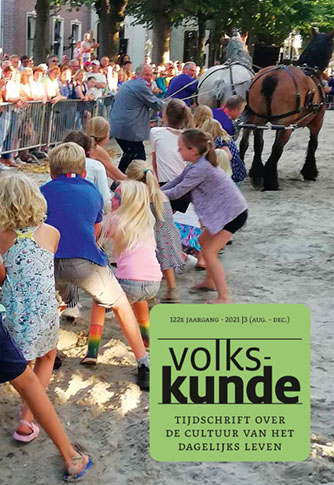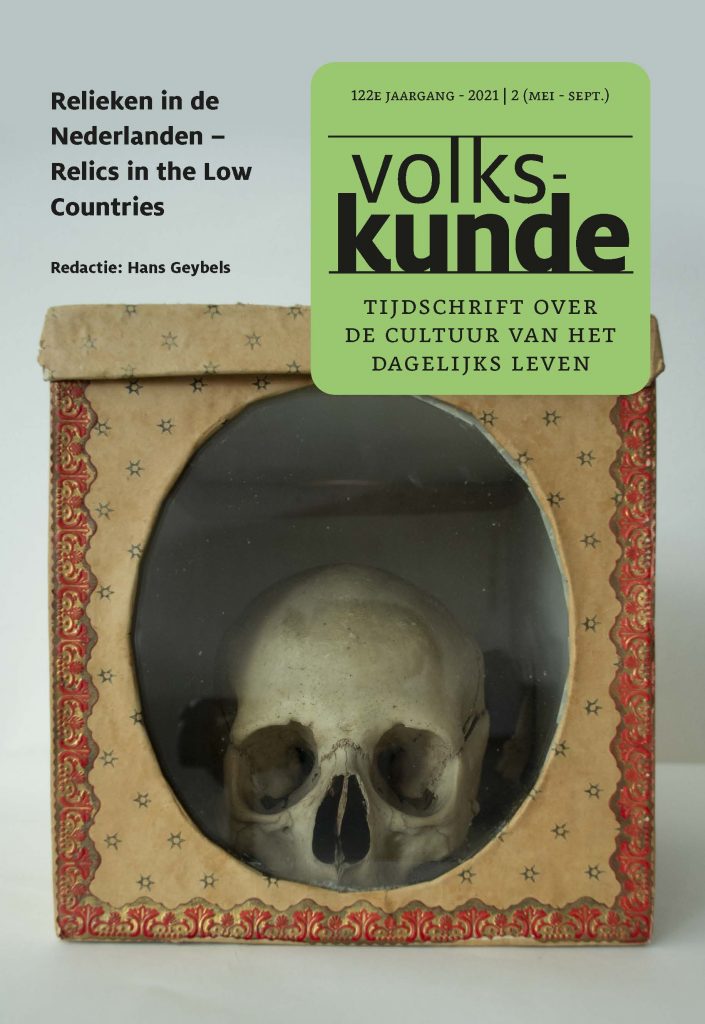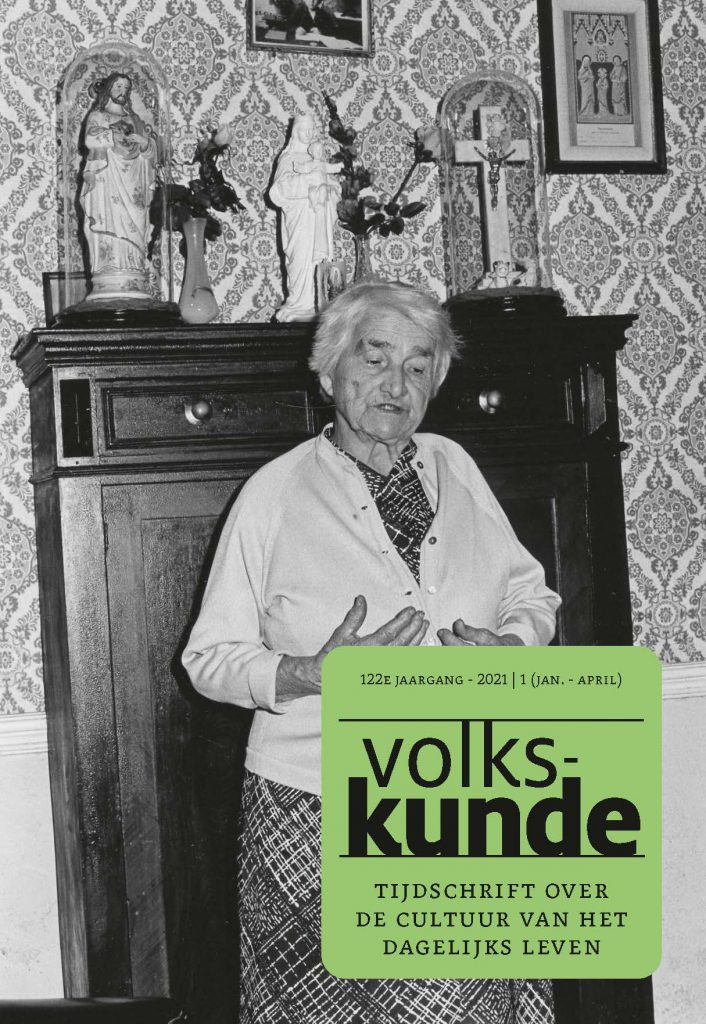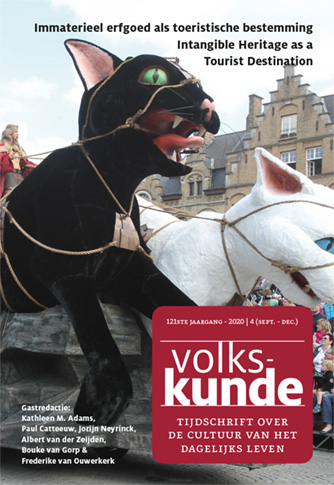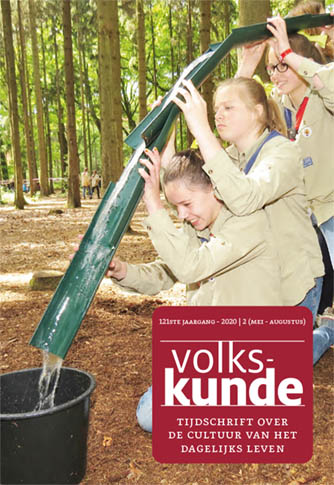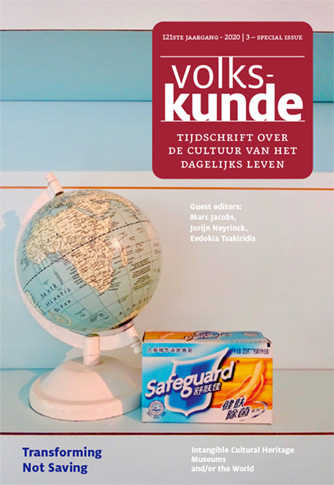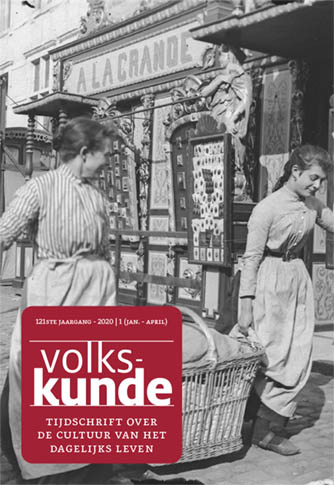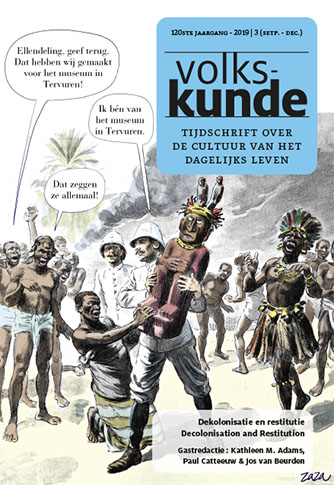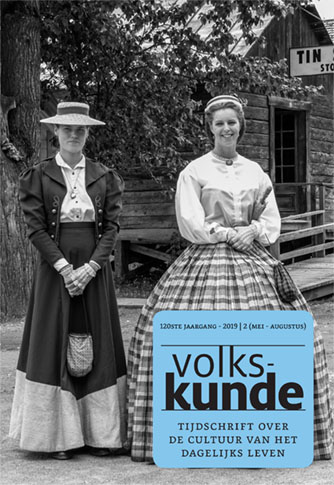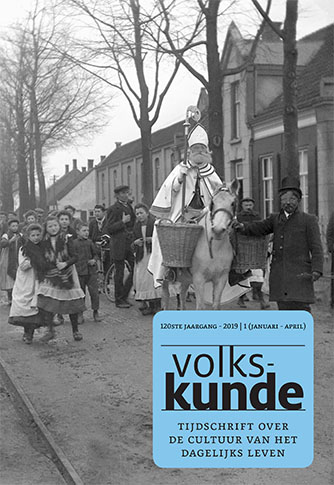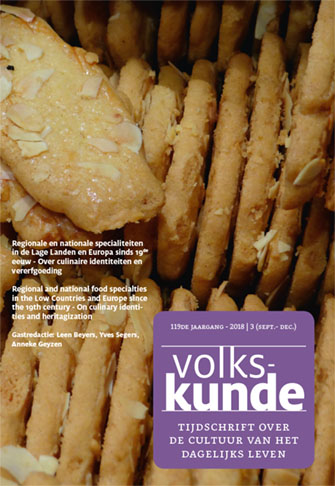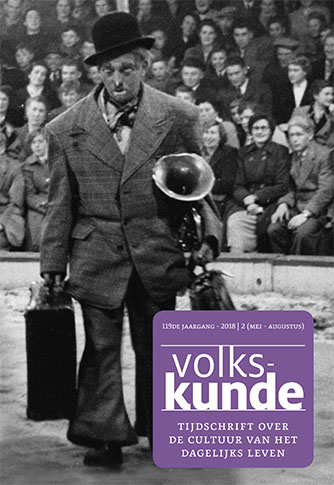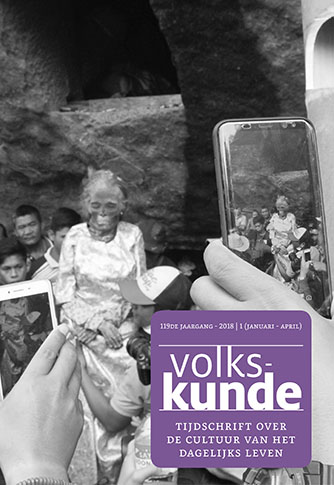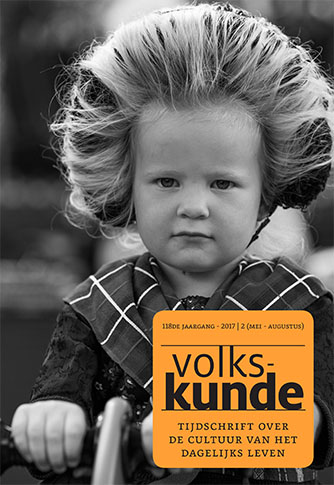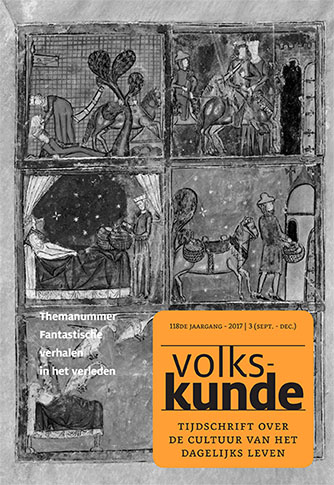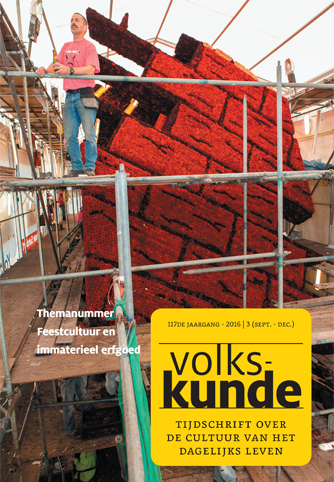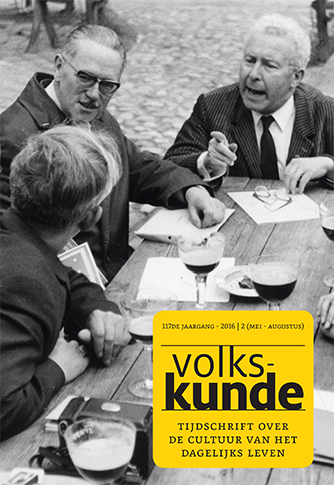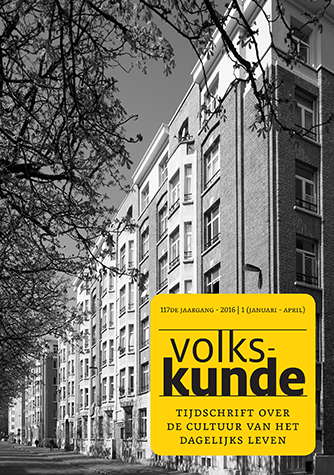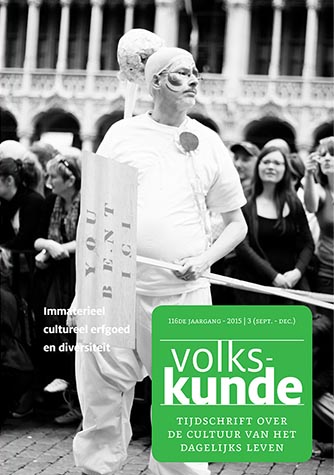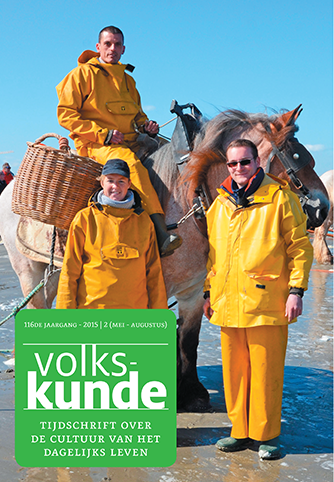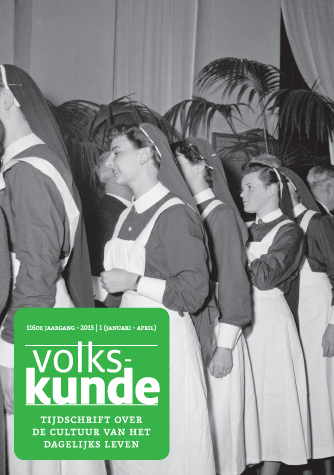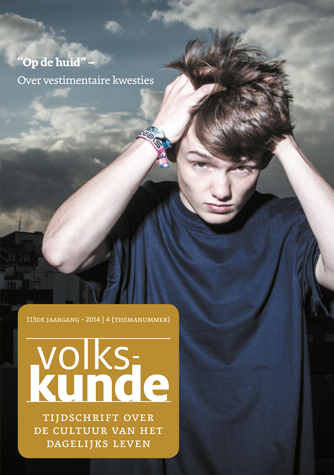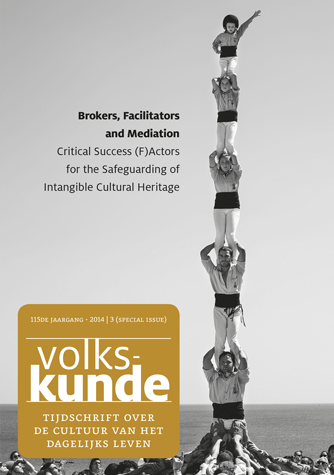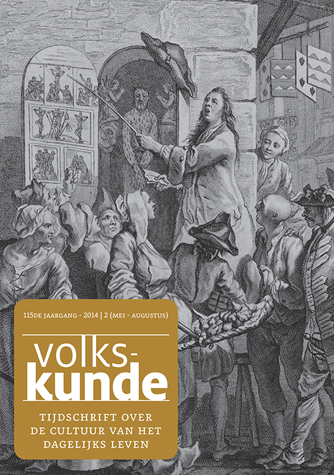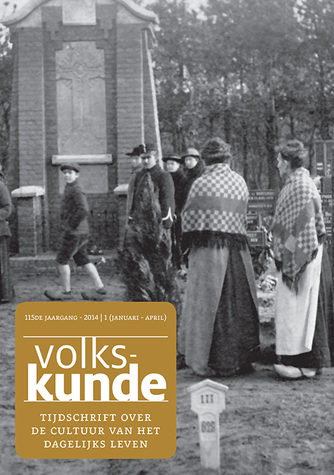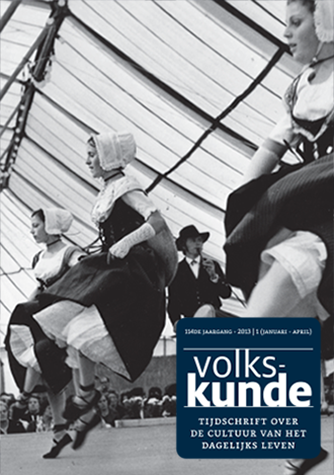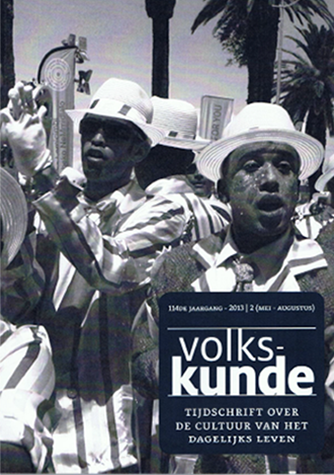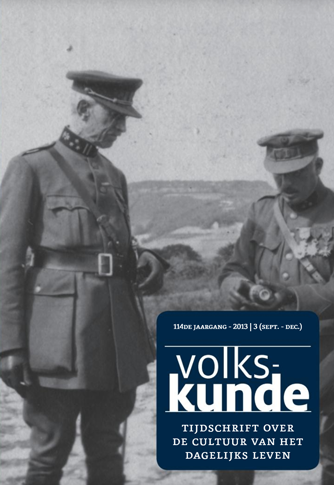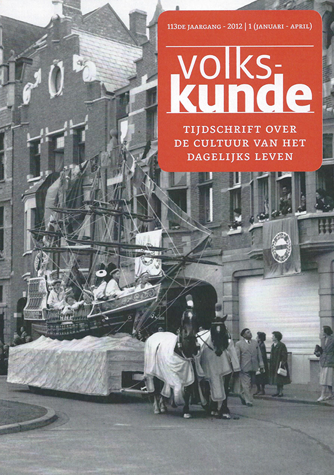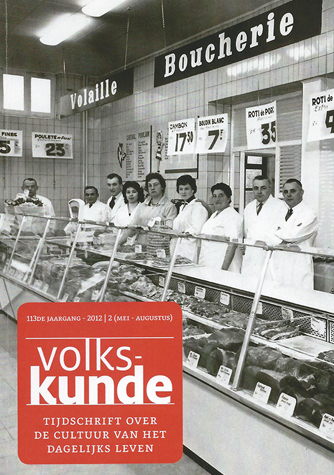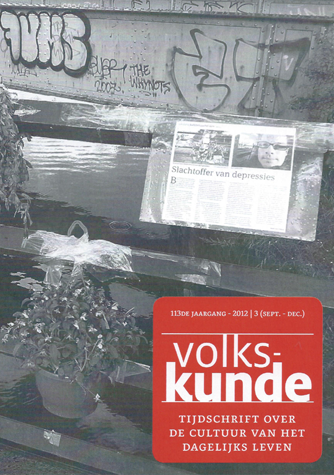2025/1
Luka HendrickxAs Tough as Clay – Goose Pulling as a Cornerstone of Antwerp Polder Identity(Hard als klei – Gansrijden als hoeksteen van de Antwerpse Polderidentiteit) Goose pulling, a game in which participants on horseback ride under a gallows to attempt the removal of a dead goose’s head, remains highly popular in six polder towns north of Antwerp, despite facing criticism …
2024/2
Karen François & Dylan Descamps, Etnowiskunde: Bourdieu toegepast op ongelijkheid binnen wiskundeonderwijsJan Willem ten Bruggencate – De Disneyficatie van Andersens ZeemeerminAmber Idzinga – Nevel, boswezen, of dwalende ziel? Over de witte wieven en witte juffers in Nederlandse sagenLuk Indesteege & Pieter Neirinckx, “Zijn wij erfgoed? Dat wist ik niet!” Ervaringen bij het verzamelen van immaterieel-erfgoedpraktijken in Belgisch-Limburg anno 2021-2024Thomas Matei, La Fidélité (1798-1819). Pomologisch levenswerk van …
2024/1
Wim Burggraaf & Sophie Elpers, ‘What are you doing?’ An exploration of local heritage communities in the context of the Faro ConventionChristoph De Spiegeleer, Peasant’s War in context. 225 years of facts and creation of an imageEls Veraverbeke, Curating War. How to collect, manage and share war as heritage in a war museum?Theo Meder, Folktale Database of the Low CountriesJan Pandelaers, A …
2022/3
Heritage in the 2020s: adjectives,Controversies and Agonistic value Marc Jacobs, Hélène Verreyke & Jiyun Zhang In the introduction to this special issue of Volkskunde on heritage and controversies, the urgency andrelevance of this topic in the 2020s are emphasized. The wave of symbolic violence and protests against statuesof persons linked with slave trade or colonization (illustrated with the case of …
2023/2
Adapting the Living HumanTreasures idea in Flanders(Belgium): The case ofcraftsmanshipAhmet Erman Aral The UNESCO 2003 Convention for the Safeguarding of the Intangible Cultural Heritage places individuals, groups and communities at the heart of safeguarding. The Living Human Treasures (LHT), although discontinued as a UNESCO programme in 2006, introduced an earlier model of this approach and is prevalent in various national …
2022/2
Castles as Art Repositories in WartimeThe hidden and lost collections of the Dutch Open-Air Museum(Nederlands Openluchtmuseum) Ingrid D. Jacobs At the end of the 1930s, the Dutch State Inspectorate for Art Protection (Nederlandse RijksinspectieKunstbescherming) stood up to protect monuments, heritage and museum collections from war threats.The most valuable possessions were stored in basements, strongrooms, school buildings, churches, and evenon ships. …
2023/1
“Goodbye then, French riffraff”.Protest songs against French rule inAntwerp (1793-1814)Brecht Deseure Singing songs is an age-old way of voicing political protest, which was widely practised in the revolutionary era. This article presents the first systematic investigation of political songs in the former Austrian Netherlands under French rule. The analysis centres on a corpus of ten anti-French songs from the city …
2021/3 Summaries
Marc Jacobs & Sophie Elpers Historian. Old-school researcher and cultural brokerThe legacy of dr. Albert van der Zeijden (1957-2021)At the sad occasion of the passing away of Albert van der Zeijden (member of the editorial board of Volkskunde), the life’s work of this scholar is presented and characterized. On the one hand, he presented himself as an academically trained historian. …
2022/1
HERWIG DE LANNOY “Wij ijveren voor een kuisch geslacht. Weg met de schunnige plakkaten!”The morality movement in Mechelen during the interbellum period The morality movement peaked during the interbellum period. The struggle against the debauchery ofmorals was waged most fiercely by Catholics who were driven by the Catholic Action Movement.They targeted fashion trends, dance bars and the new means of …
2021/2 Summaries
Jeroen Reyniers Relics and Reliquary Treasures of Saint Ursula in Belgian Limburg Saint Ursula was a king’s daughter (4th/5th century) who was murdered together with several virgins in Cologne. Possibly due to an interpretation error of the legend the cult changed to ‘Saint Ursula and the eleven thousand virgins’ in the ninth century. This legend received renewed attention thanks to …
2021/ 1 Summaries
ERIK AERTS Beer Ousts Wine Thanks to Hops? Battle for Priority as a People’s Drink in Brabant and Flanders 800-1500 In past centuries, beer and wine were the most popular alcoholic beverages, also in Northwestern Europe. Beer was the common daily drink in regions without a domestic viticulture and wine did not yet have the elitist character of the later, …
2020/4 Summaries
Een duurzame toekomst voor de Friese folklore Anne-Baukje Coster, Maaike de Jong, Alexander Grit & Sander Vroom Dit artikel verkent de kansen en uitdagingen waarmee immaterieelerfgoedgemeenschappen in Friesland te maken hebben als het gaat over cultuurtoerisme en het versterken van steden en regio’s. De relevantie van dit kwalitatieve onderzoek ligt in het verkennen van strategieën teneinde duurzaam toerisme, als een …
2020/2 Summaries
Ilaria Rosetti, Marc Jacobs & Anna Pereira Roders Erfgoed en duurzaamheid. Een literatuuronderzoek en reflectie over de rol van participatieve erfgoedpraktijken in duurzame ontwikkelin Summary: Heritage and Sustainability A review of recent literature and a reflection on the role of participatory heritage practices in sustainable development Heritage & Sustainability is an emerging multidisciplinary field. In the last decade, many studies …
2020/3 Summaries
SUMMARIES Safeguarding Intangible Cultural Heritage and Museums A Crossing of Several Projects and Trajectories Marc Jacobs, Jorijn Neyrinck and Evdokia Tsakiridis In this concise institutional introduction text, guest editors Jorijn Neyrinck, Evdokia Tsakiridis and Marc Jacobs contextualise the publication of the special issue of the journal Volkskunde on Safeguarding Intangible Cultural Heritage and Museums as a scholarly result of cooperation …
2020/1 Summaries
Nele Wynants, Wetenschap op de kermis. De verspreiding van technologie, kennis en spektakel in Belgische provinciesteden tijdens het fin-de-siècle Summary: This article will discuss the role of itinerant show people in the popularization of science and technology in the history of the Belgian fairground. Through a number of case studies at the fair in Ghent of 1892, I will demonstrate …
2019/3 Summaries
Francesca Blockeel: Portugal en zijn kolonies. Dekolonisering en teruggave van kunst Summary: Portugal and Its Colonies. Decolonisation and Restitution of Art In the sixteenth century Portugal was one of the great powers and, with Spain, a precursor in colonizing areas in Asia, America and Africa. Its imperium covers 500 years and it controlled colonies that now are situated in 53 different …
2019/2 Summaries
WENDY WAUTERS Het uitkoken van de narheid en zijn verwantschap met de geneeskunst en de alchemistische beeldtaal Summary: The Vaporisation of Folly and its similarity with early modern medicine and alchemical discourse The Vaporisation of Folly [‘Het uitkoken van de narheid’] fits within a framework of early modern evocations of the healing and makeability of men who are overcome by temporal …
2019/1 Summaries
PAUL JANSSENSWILLEN, WIL MEEUS, ELS VINCKX, SILKE LEENEN Erfgoed toegankelijk maken voor een divers publiek. Multiperspectief in het erfgoedonderwijs Making heritage accessible to a diverse audience Multiperspectivity in heritage education This article presents an instrument for the screening of programme sets for heritage education putting the focus on multiperspectivity. It contributes to the need of a sustainable cooperation between formal …
2018/3 Summaries
LOÏC BIENASSIS La place et les usages du culinaire De plaats van en vertogen over culinaire cultuur in de regionalistische Franse tijdschriften van de Belle Epoque (einde 19de- begin 20ste eeuw) In welke mate heeft de regionalistische beweging in Frankrijk begin twintigste eeuw bijgedragen aan de ‘territorialisaton’ van verschillende gerechten en producten, of anders uitgedrukt, aan de totstandkoming van streekspecialiteiten? …
2018/2 Summaries
LIESBETH GEUSSENS, Onroerende goederen – Emotionaliteit en betekenisgeving in -estamenten van Leuvense mannen en vrouwen, 1770-1780 Emotional goods Sensitivity and signification intestaments of Louvain men and women,1770-1780 Historians studying emotions have recently been using last wills to research the emotional implications of material culture and social networks. In this regard, this article tries to show in what way and to …
2018/1 Summaries
Thijs and the study of devo¬tional prints The late professor Alfons Thijs was an expert in the field of devotional prints from Antwerp (17th-19th Cen¬turies). After his death the university library of Antwerp acquired more than 1.000 prints, related to the city. The library made its ‘Thijs Collec¬tion’ available on line http://anet.be/ opac/opacuactobj. The first part of this article stresses …
2017/1 Summaries
Between taboo and tolerance 30 years of AIDS commemoration in the Netherlands The article deals with the commemoration of AIDS during the last three decades in the Netherlands. It focuses on AIDS Memorial Quilts and the rituals related to them. The quilts were made to fight intolerance against AIDS and homosexuality and to shape a commemoration community. The successful control …
2017/2 Summaries
“The White Wrap Speaks For Itself” Dynamics and Prescriptive Order in the Traditional Dress of Staphorst, c. 1950-2017 It is not for the first time that the people of the village of Staphorst in The Netherlands make out the subject of an article in Volkskunde. In 2017 a substantial but slowly diminishing number of women still wears the lo¬cal traditional …
2017/3 Summaries
Fantastical Stories in Plural: or, The Reach of Giants Historical narrative research is increasingly facilitated by internet sources, especially in the Netherlands where a service like Delpher (a combination of “delver” = miner, and “Delphi” = the oracle) provides access to millions of pages from historical newspapers, journals and books; the latter also includes the dbnl (digital library for Dutch …
2016/3 Summaries
K. DE GRAEVE, Adoptiefeesten, cultuur, liefdadigheid en gemeenschapsvorming bij Vlaams-Ethische adoptiegezinnen Summary: Adoption feast Culture, Charity and Community Building in Flemish-Ethiopian Adoptive Families Drawing on ethnographic fieldwork and interviews, this article analyses festive gatherings of Flemish parents with children adopted from Ethiopia as sites for community building, charity work and culture work. On the one hand, it reads the festive gatherings …
2016/2 Summaries
AD DE JONG, Museale passie en Europees idealisme – De jonge jaren van het Verbond van Europese Openluchtmusea 1966-1972 Summary: A Passion for Museums and for Europe – The early years of the Association of European Open-Air Museums (1966–1972) Anyone who frequently attends the conferences of the Association of European Open-Air Museums (AEOM) will eventually begin to wonder how this …
2016/1 Summaries
KARLA VANRAEPENBUSCH en ANNE-MIE HAVERMANS, Omgaan met het erfgoed van de vijand – Duitse WO1-monumenten op stedelijke begraafplaatsen in bezet België Summary: Dealing with the heritage of the enemy – German First World War monuments on city cemeteries in occupied Belgium During the First World War the Germans commemorated their fallen soldiers with monuments in the communal cemeteries in the …
2015/3 Summaries
JURIJN NEYRINCK, Van Onvoltooid Verleden naar Onvoltooide Toekomstige Tijden – Omgaan met immaterieel cultureel erfgoed en diversiteit in een wereld van verandering Summary: From Past Continuous to Continuous Future Tenses Dealing with Intangible Cultural Heritage and Diversity in a Changing World The introductory essay to this theme issue of Volkskunde on intangible cultural heritage (ICH) and diversity, provides a brief …
2015/2 Summaries
B. DENIS, Home, sweet home?! Publiek en privaat onder de loep in negentiende-eeuws Antwerpen (1880) Summary: Home, sweet Home?! The Public and Private Element in Domestic Culture (Antwerp, 1880) Contrary to the strong Anglo-Saxon tradition that predominantly draws on normative sources to study the middle class home and domestic culture, the focus is here on a broader socio-professional group. Based …
2015/1 Summaries
K. DE LEEUW, Hoebloot (niet) bedekt werd Summary:Roman catholic Repression of immoral Ways of Clothing (Tilburg, 1914-1970) In 1914 Pius X and the Roman Catholic Church launched an attack against modern women’s indecent clothing: short sleeves and skirts, low necklines, trousers, transparent or fleshcolored fabrics, etc. Modern fashion was considered to lead to improper sexual relations, to handicap a mother’s …
2014/4 Summaries
ISIS STURTEWAGEN, “Alle tsamen zo hebbelicken ghecleet”. Kinderkleding en dagelijks leven in de Brugse Bogardenschool rond het midden van de 16e eeuw. Summary: “All together respectably dressed” Children’s Dress and Daily Life at the Bruges Begard School in the mid-16th Century Both Zegher van Male’s (1514-1604) memorial of the Bruges Beghard school, a charitable institution that took care of young …
2014/3 Summaries
M. JACOBS Culturele makelaardij, omgaan met grenzen en het nieuwe paradigma van het borgen van immaterieel cultureel erfgoed. Volkskunde, UNESCO en transdisciplinaire perspectieven In dit artikel wordt de vraag gesteld welke onderdelen uit het repertoire van de al dan niet “toegepaste” of “publieke vormen” van volkskunde uit de vorige eeuw actief kunnen aangewend worden in het nieuwe, 21ste-eeuwse paradigma van …
2014/2 Summaries
V. VANRUYSSEVELDT Tussen niche en overlevingsstrategie? Rondtrekkende artiesten in het hertogdom Brabant in de tweede helft van de achttiende eeuw Summary: Itinerant entertainers in Brabant (1766-1775) Itinerant entertainers (musicians, singers, puppet players, bear dancers and other artists) used to play an important role in popular culture in preindustrial Europe. Negative connotations about these people have prevailed in modern historiography while …
2014/1 Summaries
T. HENS, S. VANDEN BORRE en K. WILS De oorlog maakt school – Herinneringspraktijken in het Belgische onderwijs na de Eerste Wereldoorlog Summary: Patriotism kindled in Belgian schools after the Great War Immediately after the First World War the propagation of a unified and patriotic war narrative was an important issue for the Belgian Government in primary as well as …
2013/1 Summaries
D. CALLEWAERT Schriftelijke transcommunicatie: over hemelbrieven en tekstamuletten Summary: Transcommunication in writing: the heavenly letter In revealed religions transcendental communication by means of a heavenly letter used to be a marginal modus operandi. A letter from heaven is quite distinct from the (well-known) votum scriptum which the faithful commonly send to heaven. An apocryphal Sunday Epistle fell from heaven in …
2013/2 Summaries
A.M. VAN DER WAL Een pijnlijk verleden, een onzekere toekomst – Levend erfgoed van het slavernijverleden in postapartheid Zuid-Afrika Summary: A painful past, an uncertain future Living heritage of slavery in postapartheid South Africa The year 2013 marks not only the 150th anniversary of the abolition of slavery in the Kingdom of the Netherlands, but also the 10th anniversary …
2013/3 Summaries
A. VANNESTE De Belgisch-Nederlandse grens onder spanning Summary: The 2.000-volt Belgian-Dutch frontier (1915-1918) The German Army built a three-wired entanglement in order to cut off occupied Belgium from The (free) Netherlands. The wire, as it was called, was impressive (more than 350 km long, from the Belgian coastline in Knokke up to little short of Aachen) and it was deadly …
2012/1 Summaries
E. VANDEWEGHE Feesten van nostalgie en vooruitgang: de representatie van het stedelijke landschap in Vlaamse provinciesteden 1837-1958 Staging urban history: Festivities and the creation of historical townscapes in Belgium (1860-1958) Parades were an intrinsic part of urban life in Belgium between the middle of the nineteenth and twentieth century. Scholars have used these festivities time and again to probe into …
2012/2 Summaries
W. SCHEIRE Geschiedschrijving van het evidente. Het verhaal van de koelkast Summary: A history of the evident: the Story of the Refrigerator Nowadays a refrigerator figures as an unspectacular and banal dimension in everyday life. In fact, it has been taken for granted by most of us. But since it was introduced in the last century it has affected (post-war) …
2012/3 Summaries
D. HERREMANS, W. DE CLERCQ De herinnering blijft. Memoria en materiële cultuur in de monastieke ruimte van Clairefontaine (B) Summary: A place to remember. Memoria, material culture and monastic space in the Cistercian nunnery of Clairefontaine (B) The Cistercian nunnery of Clairefontaine was founded in the 13th century by the Counts of Luxembourg. During the 13th and the 14th century …
2011/1 Summaries
A.K.L. THIJS Vera Effigies? Vindingrijke omgang met drukvormen: productiekosten reducerende beeldmanipulatie bij bedevaartprenten Vera Ogies? Creative engraving leads to cast reduction as well as to unauthentic imagery at holy pilgrimage sites In the preindustrial era image manipulation enabled publishers to cut production costs by reusing printing blocks, even in a quite different context. They sometimes altered the image a litde …
2011/2 Summaries
D. CALLEWAERT De subjectieve en collectieve tijdservaring vanuit een volkskundig perspectief The individual and collective experience of time: an ethnological analysis Personifications, attributes, images and expressions render the concept time less abstract. Indications of time are not always mathematical data because in a special context they too often have an emotional value (e.g. nine eleven, 31st of october …
2011/3 Summaries
J. TAELS Over humor, levenskunst en tragiek On Humour, Art of Life, and the Tragic In his philosophical approach J. Taels attempts to elucidate two central meanings of humour: humour as the synonym of the comic, and humour as an art of life. In the first section he discusses several central aspects of humour in the broad sense, which relates …
2011/3 Summaries
J. TAELS Over humor, levenskunst en tragiek On Humour, Art of Life, and the Tragic In his philosophical approach J. Taels attempts to elucidate two central meanings of humour: humour as the synonym of the comic, and humour as an art of life. In the first section he discusses several central aspects of humour in the broad sense, which relates …
2011/4 Summaries
A.K.L. THIJS Het liedeken vande joffrouw van Brugge en haar catteken: lachen om de sentimentalisering van de omgang met een eigenwillig huisdier Ridiculing too sentimental a relation with pets: the song about a young lady of Bruges and her beautifid but headstrong small cat These days the cultural-historical interest in the man-animal relation hos grown considerably. Yet in Flanders this …
2010/1 Summaries
.S. TOP De Hellejongen. Een Vlaamse duivelssage als casus The Hell Boy: A Flemish Devil Legend as Case Study Concerning Literacy versus Orality With his epic poem ‘Legend of the Hell Boy’ (1883), the common practitioner Karel de Gheldere (1839-1913) has witten the following fascinating story. An angry step-mother hates her lazy son and wants her husband to hire him …
2010/2 Summaries
A.K.L. THIJS Verzamelaars en producenten van bedevaartvaantjes (1853-1970). Emotionele omgang met traditioneel religieus erfgoed Summary: Collectors and makers of pilgrimage pennants (1853-1970). An emotional approach to a traditional religious legacy This contribution verifies which meanings have been attributed by historians and folklorists to the medium of pilgrimage pennants and how collectors have tried to influence the production, shaping and distribution …
2010/3 Summaries
N. BOERMA De 17de-eeuwse Nederlandse kinderprent Summary: The Dutch children’s print of the seventeenth century: comic strip or only a precursor? At the exhibition in Venlo Suske and Wiske the story tellers fl& of phantasy is exposed a print the Life of Klaas and Griet. Klaas is a softie, who is beaten by his wife Griet, who really is a …
2010/4 Summaries
D. CALLEWAERT en M. VAN DEN BERG Volkskundige aspecten van meer dan honderd jaar conscripties en loting (1798-1909) Customs in Flanders Regarding Conscription and Substitution (1798-1909) The French revolutionaries introduced – in France as well as in the occupied territories – a compulsory military service for all young men, regardless of their social class (Law Jourdan, 1798). The adequate number …
2009/1 Summaries
A.K.L. THIJS Een onbescheiden blik in de portefeuille van de Volkskunde-redacteur: Victor de Meyere (1873-1938) bespied met het bricoleren met kopij Summary: An indiscreet look onto the portfolio of a Volkskunde editor: watching Victor de Meyere (1873-1938) tinkering with a copy. Unedited copy of Victor de Meyere’s portfolio for volume 1938 of the Volkskunde magazine Recently, a printing ready copy …
2009/2 Summaries
A.K.L. THIJS Den Lustelijcken Mey. Het incipit van een populair lied gerecycleerd tot titel van een devotieboekje door Paulus Fabri (Brussel, 1600) Summary: “Den Lustelijcken Mey“, an ambiguous incipit of a popular devotional booklet “Den Lustelijcken Mey” is the opening line of two quite different songs, a religious and a romantic one. Paulus Fabri, a priest, remarkably chose this ambiguous …
2009/3-4 Summaries
A. VAN DER ZEIJDEN De actualiteit van tradities en het jaar van de tradities: een inleiding Summary: Traditions have again become current topics: an introduction The Dutch Year of Traditions is a nice occasion to explore the theme of traditions. Traditions are in. Marketing experts say that it has to do with the fact that we live in a retrospective …
2008/1 Summaries
A. VRINTS De codes van de kroeg. Het openbaar lokaal tussen orde en wanorde in Antwerpen (1910-1950) Summary: Codes of the pub. The public room between order and chaos in Antwerp (1910-1950) Since the elite stopped visiting the pub in the early modern era, they started considering pubs and drinking to be a source of ‘chaos’ in all kinds of …
2008/2 Summaries
A.K.L. THIJS La Germanistique mène à tout…”. Frans M. Olbrechts (1899 – 1958). In het wereldje van volkskundigen en etnologen Summary: Frans M. Olbrechts (1899-1958) in the small World of folklorists and ethnologists Frans Olbrechts started his career as a folklorist with a thorough study of Flemish incantations. But he is best-known as an expert of African art and American …
2008/3-4 Summaries
A. DHOEST Eén Vlaanderen? Culturele diversiteit op en voor het televisiescherm. Summary: One Flanders? Cultural diversity on and in front of the television screen This article asks two questions; how does Flemish television represent the modern multicultural society in fictional programs and how do autochthon and immigrant viewers feel towards it? A short overview of the current Flemish fictional offer …
2007/1 Summaries
A.K.L. THIJS Naar een tweetalig volkskundig tijdschrift? Emile van Heurck (1871-1931) en de heroprichting van Volkskunde na de eerste wereldoorlog Summary: On to a popular bilingual magazine? Emile Van Heurck (1871-1931) and the re-establishment of Volkskunde after WO I. In 1919, Eugène de Bock of the publishing house De Sikkel tried to start again with the magazine Volkskunde (of which …
2007/2 Summaries
A.K.L. THIJS Lyn de melkboerin en de Brabantse omwenteling (1789). Context en bron van een Antwerps Liedfragment Summary: Lyn the Milk farmer’s wife and the Brabant Revolution (1789). Context and source of an Antwerp song fragment In 1860, an orally handed down song fragment was published in which Lyn the Milk farmer’s wife ‘a bronze statue that adorned a pump …
2007/3 Summaries
D. CALLEWAERT Het boze oog Summary: The Evil Eye From times immemorial many people from all over the world have been convinced that a special, (un)intentional, frontal eye contact of a person or animal can harm people, live stock, goods and chattels. This belief has remained intact because of news items, stories for young and old, computer games and comics, …
2007/4 Summaries
A.K.L. THIJS Drukvormen voor mannekensbladen van Brepols & Dierckx Zoon (Turnhou): Een gebruikstraject van volkscultureel erfgoed gereconstrueerd Summary: Printing forms for folk- and children prints by Brepols & Dierckx Son (Turnhout): A reconstruction of the multi-purpose of popular culture heritage The story of the wooden printing forms that the popular expert Emile van Heurck bought from the rinting-publishing house Brepols …
2006/1 Summaries
B. DESEURE Questie en Afdronk: sociale codes in het openbare lokaal op het Noord- Brabantse platteland in de nieuwe tijd Summary: Questie en Afdronk: Social codes at the public space in the North-Brabant countryside during the New Time Based on process files, this article gives a view on the social interaction at inns in the North-Brabant countryside. At the centre …
2006/2 Summaries
B. DESEURE Questie en Afdronk: sociale codes in het openbare lokaal op het Noord- Brabantse platteland in de nieuwe tijd Summary: Questie en Afdronk: Social codes at the public space in the North-Brabant countryside during the New Time Based on process files, this article gives a view on the social interaction at inns in the North-Brabant countryside. At the centre …
2006/3 Summaries
K. CAMPS Speelgoed in meisjeshanden Summary: Toys in Girls’ Hands “The difference between boys and girls defines the way they play, not the actual objects they are playing with.” This statement of Marianne De Valck dates from 1996. Opinions on boys- and girls’ play weren’t always that broad-minded. Toys, as a mirror of society, display a magnificent image of the …
2006/4 Summaries
P. SCHOLLIERS Voedingsonderzoek over de 19de en 20ste eeuw in België, Nederland en Europa Summary: Research into the eating habits in the 19th and 20th century in Belgium, the Netherlands and Europe. This essay situates the Dutch and Flemish research into the eating culture in 19e and 20e century Europe. The emphasis lies on the historiographic developments since 1980. The …
2005/1-2 Summaries
G. DE MEYER De studie van populaire cultuur en van volkscultuur Summary: The study popular culture and folk culture In this article we outline the traditional position, however under discussion, of the study matter of folklore and popular culture. It is arguable that in both fields of study quite often the same discourse is being used, namely as far as …
2005/3 Summaries
D. BILTEREYST en R. VANDE WINKEL De sportfilms van Flandria Film als verspreiders van ‘banaal’ Vlaams-Nationalisme en wielerflamingantisme (1930-1940) Summary: “Flandriens“, film and popular culture ‘Flandriens’ is the French name for the best of Flemish cyclists. The sports films of Flandria Films aim at the dissemination of ’trite’ Flemish nationalism and cycle flamingantism (1930-1940). In this article we focus on …
2005/4 Summaries
A.K.L. THIJS Een lied in zijn functionele context herplaatst: “De dood te gast genood” Summary: A song replaced in its functional context A West-Flemish manuscript dated around 1757 holds a version of the popular song about a dead who’s invited to a feast (Aarne – Thompson 470 A: The Offended Skull). The composition of the volume (religious songs, prayers and …
2004/1 Summaries
E. ROBAERT Zestiende-eeuwse bedevaarttekens en legpenningen in enkele Brusselse en Brabantse kerken: Jan Noë de vaantjesmaker van Halle Summary: 16th century pilgrims tokens and medals in some Brussels and Brabant churches. Jan Noë, the flag producer from Hale (a town in Brabant). Pilgrims’ tokens and medals were large-scale productions, sold by specialised stallholders and other 16th century salesmen. Jan Noë …
2004/2 Summaries
A.K.L. THIJS Recreatie, educatie, devotie en informatie: functies van populaire lectuur (17de – 19de eeuw) Summary: Entertainment, education, devotion, and information: function of popular reading matter (17th – 19th centuries) Popular reading matter was the favourite reading material of ordinary people. Wether or not an author or an editor with his publication aimed at ‘popular’ readers, can often be derived …
2004/3 Summaries
C. DE STAELEN Een venster op de materiële leefwereld van Elisabeth Moretus Summary: A view on the material culture of Elisabeth Moretus Based upon an inventory the material culture in the house ‘De Grote Lynde’ is explained and explored. The description is complemented by a housekeeping journal written by the occupant, Elisabeth Moretus in the years 1664-1675. Both documents evoke …
2004/4 Summaries
A. VAN DER ZEIJDEN Traditie en Folklore: pleidooi voor een herwaardering en een nieuw leven van twee oude begrippen Summary: Tradition and folklore. A plea for a revaluation and a new life of two old concepts Tradition and folklore are concepts preferably avoided by serious scientists. These concepts are too much emotionally charged with the old prejudices about the supposed …
2003/1 Summaries
A.K.L. THIJS Toe-eigening van volkskundige verschijnselen: enkele voorbeelden uit de historiografie van de volkskunde in Vlaanderen (circa 1880-1930) Summary: “Appropriation” and its usefulness in folklore In this contribution the author checks the usefulness of the concept “appropriation” (in Dutch: toe-eigening) as defined by Frijhoff in 1997. Appropriation is the attribution of a meaning (personal and group-linked interpretation) to cultural phenomena …
2003/2 Summaries
A. VAN DER ZEIJDEN Volkscultuur in een nieuwe jas Summary: Popular culture gets a face-lift The collection “Alledaags is niet gewoon. Reflecties over volkscultuur en samenleven” (Plain things are uncommon. Reflections on popular culture and society) brought out in 2002 and edited by the “Koning Boudewijnstichting” (Foundation King Boudewijn) gives a good view on current trends of popular culture pursuing …
2003/3 Summaries
M.M.A.C. LANGENHUIJSEN Votiefgeschenken: epidemiologie avant la lettre Summery: Votive offerings: epidemiology before the term existed Based on a study of literature concerned and on observations of the authorhimself, data have been gathered of 55,327 votive offerings representing parts of the body and human images. All these were or still are present in places off pilgrimage in America and Europe and …
2003/4 Summaries
A. ROECK, Prof. dr. K.C. Peeters Summary: Prof. dr. K.C. Peeters In this article, A. Roeck explains how he became K.C. Peeters’ first student to write, under his guidance, the dissertation that led to his Master’s Degree. The subject was the collection and study of oral legends. Peeters insisted on using new working-methods. After his graduation K.C. Peeters asked Roeck …
2002/1 Summaries
E. ROOBAERT Jeruzalemvaarders, rederijkers en schilders en de Palmzondagsprocessie te Brussel in de 16e eeuw Summary : Jerusalem Knights, rhetoricians, painters and Palm Sunday Procession In Brussels in the 16th century On the basis of unknown data the author draws a picture of the Brussels Palm Sunday procession in the 16th century. Ghysbrecht Mercx, one of the well-known rhetoricians of …
2002/2 Summaries
A. VAN DER ZEIJDEN Vrouwen in de volkskunde ten tijde van het Interbellum: de factor gender in de wetenschapsbeoefening Summary: Women folklorists in the interbellum period : the factor “gender” in practising science Men completely set the sence in recent surveys of the history of folklore in The Netherlands and in Flanders. Is this conclusion in line with reality, or …
2002/3 Summaries
A.K.L. THIJS Zakelijke inhoud van het persoonlijke dossier van Max Elskamp betreffende het Antwerpse “Museum voor Foklore”, het allereerste volkskundemuseum in Vlaanderen (1907) Summary : Looking into Max Elskamp’s private letters and documents concerning the Antwerp “Museum voor Folklore”, the very first museum of foklore in Flanders (1907) In 2001 the “Vrienden van het Volkskundemuseum van Antwerpen” (Friends of the …
2002/4 Summaries
A. DHOEST Weeral Bokrijk!’ Het ‘Folkloristische’ beeld van Vlaanderen in historische TV-fictie Summary : “Bokrijk again!” The ‘folkloristic’ image of Flanders in historical television fiction. Historical serials were the most important fiction genre in Flemish television in the tume when the public broadcasting system had exclusive rights. For the most part these serials showed a rather folkloristic picture of Flanders …
2001/1 Summaries
A.K.L. THIJS De Antwerpse Ommegang in 1599 Summary : The Antwerp “Ommegang” in 1599 On the basis of the acquittances of the Antwerp audit office, the author tries to reconstruct part of the Whitsun Ommegang (a historic and aristocratic pageant) of June 6th 1599. An earlier hypothesis put forward by C. Leo Truyens (1884-1970) who thought that the Archdukes’ lacework …
2001/2 Summaries
E. ROOBAERT Brusselse bedevaarders en hun bedevaarten in de 16e eeuw Summary : Brussels pilgrims and their pilgrimages in the sixteenth century. Starting from a thorough examination of the archives (National Public Record Office in Brussels, Church archives of the province of Brabant, Archives of the chapter church of St. Michael and St. Gudula, Archives of the Public Centre for …
2001/3 Summaries
B. BOUCIQUE De drakendoder en zijn trouwe dieren (AT 300) in de Vlaamse en internationale sprookjestraditie Summary : The dragon killer and his faithful animals (AT 300) in The Flemish and international tradition of fairy tales. This article is the summury of some research on the 16 Flemish variants of the fairy tale type ‘The dragonslayer” (AT 300). Conclusions about …
2001/4 Summaries
H. BOONE De Polka Summary : The Polka In this contribution Hubert Boone especially emphasizes the cultural- historical and the musical-technical aspects of the polka, a dance enthusiastically welcomed in Western Europe in the middle of the 19the century. The author discusses the origin of the polka and holds Rudolf Voss’s view in that the polka was not a new …
2000/1 Summaries
J. GANSEMANS, Frans Olbrechts – Een hart en een visie voor Tervuren Summary : Frans Olbrechts. A renewing role in the Tervuren museum From 1947 until his death in 1958 Olbrechts also held the directorship of the Museum van Belgisch Congo (Belgian Congo Museum) in Tervuren. Dr. Gansemans dwells upon his inspiring and renewing role in the Tervuren museum. . …
2000/2 Summaries
A.K.L. THIJS Private en openbare feesten: communicatie, educatie en omgaan met macht (Vlaanderen en Brabant, 16de, midden 19de eeuw) Summary : private and public festivities. Communication, education and coping with power (Flanders and Brabant, 16th till mid 19th cent) Festivities perform within an extensive communication process. Individuals and groups are given the possibility to pass on all sorts of information. …
2000/3 Summaries
D. CALLEWAERT Overlijden en afscheid in het Brugse 1900-2000 Summary : In ‘Dying and Commemoratings in the Environs of Bruges 1900-2000‘ special attention is paid to one suburb because in Sint-Kruis several classed ended up on the same place, though in a different way. The local population has been buried on its churchyard(s) but the upper class of the city …
2000/4 Summaries
B. DE CREMER Volksgeneeskunde nu: een evaluatie van alternatieve geneeswijzen als volwaardige aanvulling of tegenhanger van reguliere geneeskunde Summary : In 1996-1997 the study group “Popular Medicine” of Leuven University, developed and distributed inquiry forms in order to investigate the medical consumption, based on 100 inquiry forms related to the village of Wilsele in Flemish Brabant, the author tries …

